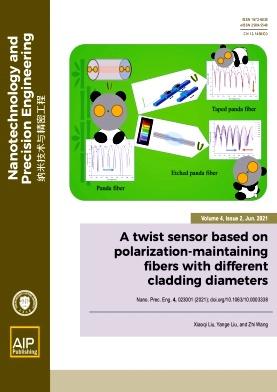Ultra-precision machining of cerium-lanthanum alloy with atmosphere control in an auxiliary device
IF 2.7
3区 工程技术
Q2 MATERIALS SCIENCE, MULTIDISCIPLINARY
Nami Jishu yu Jingmi Gongcheng/Nanotechnology and Precision Engineering
Pub Date : 2022-09-01
DOI:10.1063/10.0013777
引用次数: 2
Abstract
Cerium–lanthanum alloys are the main component of nickel–metal hydride batteries, and they are thus an important material in the green-energy industry. However, these alloys have very strong chemical activity, and their surfaces are easily oxidized, leading to great difficulties in their application. To improve the corrosion resistance of cerium–lanthanum alloys, it is necessary to obtain a nanoscale surface with low roughness. However, these alloys can easily succumb to spontaneous combustion during machining. Currently, to inhibit the occurrence of fire, machining of this alloy in ambient air needs to be conducted at very low cutting speeds while spraying the workpiece with a large amount of cutting fluid. However, this is inefficient, and only a very limited range of parameters can be optimized at low cutting speeds; this restricts the optimization of other cutting parameters. To achieve ultraprecision machining of cerium–lanthanum alloys, in this work, an auxiliary machining device was developed, and its effectiveness was verified. The results show that the developed device can improve the cutting speed and obtain a machined surface with low roughness. The device can also improve the machining efficiency and completely prevent the occurrence of spontaneous combustion. It was found that the formation of a build-up of swarf on the cutting tool is eliminated with high-speed cutting, and the surface roughness (Sa) can reach 5.64 nm within the selected parameters. Finally, the oxidation processes of the cerium–lanthanum alloy and its swarf were studied, and the process of the generation of oxidative products in the swarf was elucidated. The results revealed that most of the intermediate oxidative products in the swarf were Ce3+, there were major oxygen vacancies in the swarf, and the final oxidative product was Ce4+.气氛控制辅助装置中铈镧合金超精密加工
铈镧合金是镍氢电池的主要成分,是绿色能源产业的重要材料。然而,这些合金具有很强的化学活性,表面容易氧化,给其应用带来了很大的困难。为了提高铈镧合金的耐蚀性,必须获得低粗糙度的纳米级表面。然而,这些合金在加工过程中很容易自燃。目前,为了抑制火灾的发生,在环境空气中加工该合金需要以极低的切削速度进行,同时向工件喷射大量切削液。然而,这是低效的,只有非常有限的参数范围可以在低切削速度下进行优化;这限制了其他切削参数的优化。为了实现铈镧合金的超精密加工,研制了一种辅助加工装置,并对其有效性进行了验证。结果表明,该装置可提高切削速度,获得低粗糙度的加工表面。该装置还可以提高加工效率,完全防止自燃的发生。结果表明,高速切削消除了刀具上结块的形成,在所选参数范围内,表面粗糙度(Sa)可达5.64 nm。最后,对铈镧合金及其结块的氧化过程进行了研究,阐明了结块中氧化产物的生成过程。结果表明:金属屑中间氧化产物以Ce3+为主,金属屑中存在较大的氧空位,最终氧化产物为Ce4+。
本文章由计算机程序翻译,如有差异,请以英文原文为准。
求助全文
约1分钟内获得全文
求助全文
来源期刊

Nami Jishu yu Jingmi Gongcheng/Nanotechnology and Precision Engineering
Engineering-Industrial and Manufacturing Engineering
CiteScore
6.50
自引率
0.00%
发文量
1379
审稿时长
14 weeks
 求助内容:
求助内容: 应助结果提醒方式:
应助结果提醒方式:


